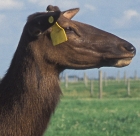Dec 08, 2004The United States Department of Agriculture (USDA) has begun a program that uses RFID technology to track tag captive deer and elk in the U.S. By tagging individual deer and elk, the USDA will be able to research the movement of the animals and determine how they are contracting chronic wasting disease (CWD), a fatal neurological disorder. At this point, scientists do not know how the disease is spread.
The USDA purchased RFID tags and readers from Digital Angel, a St. Paul, Minn., company that makes systems used to wirelessly identify and track people, animals and assets. Digital Angel is supplying enough passive RFID tags for 100,000 animals and about 200 RFID readers for a total of $200,000. The tags and readers are being distributed to cervid (deer and elk) farms in about 10 different states, where the animals are raised for meat, antlers and hides. Cervid farmers or veterinarians employed by the USDA (depending upon the state) will affix the tags to deer and elk. The tags will allow the USDA, as well as state agencies and farmers, to track the animals' movements as they leave and enter a new farm. The readers will also be installed at feeding sites or salt licks on certain farms, so the USDA will be able to track where deer and elk travel while at those farms.
CWD belongs to a family of diseases known as transmissible spongiform encephalopathies, which includes mad cow disease. The disease attacks the brains of infected deer and elk, causing the animals to become emaciated, display abnormal behavior, lose bodily functions and die. Besides being found in captive deer and elk, the disease has also been found in wild deer and elk in eight states and one Canadian province. There has never been a case of human contraction of CDW, so the spread of the disease is more of a trade issue than a health one. American farmers are unable to export antlers to one of their largest markets, Korea, because of the presence of CWD in the U.S.
"Our overall goal is to eliminate CWD from the United States," says Amy Spillman, spokesperson for the Animal and Plant Health Inspection Service (APHIS) of the USDA. "We hope that the data we will be gathering will help." By determining how the disease is transmitted, the USDA hopes to eradicate it from deer and elk in both the domestic and wild environment. If, for example, an animal is found to be carrying the disease when harvested, the RFID records will show where that animal has been and what other animals have been near it at what times. By following these records, the USDA hopes to determine where, when and how the animal was infected.
Each young elk or deer will be tagged with a passive RFID transponder that is either molded into a plastic button with a stud that pierces the animal's ear or a plastic tag that hangs from the ear. The passive tag use a frequency of 134 kHz and comply with ISO standard 11784 and 11785, and the only data on a tag is an ID number unique to that animal.
Most of RFID readers used in the CWD program will be handheld, wand-style devices, according to Spillman. "The RFID devices may help us track animal movement more efficiently," she says. Before the USDA started using RFID tags, deer and elk had been tagged with printed number identification that had to be manually read and recorded at each point of transfer, such as movement to a new farm or at time of harvesting. Now, instead of stopping each animal, holding its head and visually reading the number on its tag, personnel can simply place the wand near the animal as it passes. Data from the RFID reader then goes to the USDA database. The Digital Angel scanner can be Bluetooth-enabled so the information can be uploaded to any Bluetooth device, or the USDA can use a wireless or wireless connection to PC or though the Internet. How the data is collected may vary from state to state.
In addition to using handheld readers, the CWD program will install stationary RFID readers near feeding areas and salt licks. The readers are designed to withstand the abuse of 1,000-pound animals knocking against them, according to Kevin McGrath, Digital Angel chief executive officer. Handheld readers can read tags up to 6 inches away; the stationary readers can read the tags from 12 to 18 inches.


